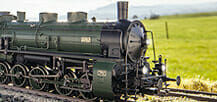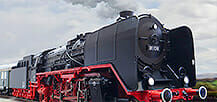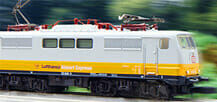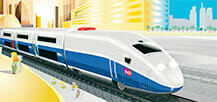Immerse Yourself in a New Dimension of Operating
Developments in model railroading keep moving forward. The mfx decoders with up to 16 special functions set standards for all model railroaders. More ease of use, closer to the prototype, more operating enjoyment. More operating enjoyment! Märklin accepted this and developed the mfx decoder further. The Märklin "World of Operation" with the mfx+ decoder is now available for operation close to the prototype.
Operating a model railroad is thereby even more realistic and closer to the prototype. To do this, you need the 60213 – 60215 Central Station that has been offered since 2008 and that has the latest firmware version installed. A new feature on the mfx+ decoder is that it has a virtual supply of operating materials (fuel, water, sand, etc.) corresponding to the prototype. This supply goes down as the locomotive is operated and it must be replenished.
Consumption of these materials increases for example with a full load and on a grade. On an electric locomotive, sanding plays a role. On a diesel locomotive, the fuel is the focus, and on a steam locomotive, water and coal in addition to sand are the focus. When the supply of a component is consumed, this leads unavoidably to disruption of the running operation of the locomotive.
The locomotive then goes into "coasting mode" until the missing sand or fuel is replenished. This part of the decoder was intentionally designed not to stop operation entirely. Another special feature is the "Sifa button" or "dead man's throttle" on a diesel and an electric locomotive. This button must be pressed at regular intervals by the "locomotive engineer" just as on the real life railroad in order to avoid forced braking of the train.
Read articles about practical applications from the Märklin Magazin
You can choose from among four operating modes to control an mfx+ locomotive:
Standard: The locomotive behaves like a normal mfx locomotive with no consideration for the consumption of fuel, water, and/or sand.
Semi-Advanced: The consumption of fuel, water, and/or sand is activated. The user interface on the Central Station 2 is supplemented by the display of the supply of the fuel, water, and/or sand and a button for taking on fuel, water, and/or sand.
Advanced: A recreation of the cab for an electric locomotive, a diesel locomotive, or a steam locomotive will appear. The locomotive is now controlled according to the typical operating procedures that are customary in the real life prototypes.
Specialist: You need to have a fully wired layout in order to be able to run the model in this mode. By using feedback contacts, you determine exactly where the locomotive must take on fuel, water, and/or sand. In the advanced and specialist modes, the locomotive must be prepared according to the mode of operation in order to be able to put it into motion.
The fire has to be started in the boiler of a steam locomotive and the boiler pressure must be correct for operation. On the electric locomotive, the main switch must be turned and the pantograph must be up. You can get support for the control of the locomotive be means of information on the Central Station's display.
If you have an external speaker and connect it to the Central Station, you will also get an acoustic signal. When the engineer's cabs were being designed for the Central Station, the individual cabs of different classes of locomotives were intentionally "standardized". The emphasis was more on operating enjoyment in the selection and placing of the individual operating elements.
The operating steps should be typical for the mode of operation in question, simultaneous but also easy to understand. Probably the most interesting cab for many model railroaders is the steam locomotive. In addition to sufficient fuel, water, and sand here the boiler pressure has to be monitored constantly, the water level in the boiler has to be adjusted, and sufficient steam has to be sent to the cylinders. This is the most interesting but also the most challenging mode of operation.
Data Are Stored
Incidentally, the data about the level of supply for fuel, water, and/or sand are stored in the locomotive. For example, if the locomotive is registered on the Central Station with Firmware Version 2.5 for a group or a friend, the data are also available there again directly as a starting point after the selection of the desired mode of operation. Operating the locomotive on a device without this operational possibility does not change the data.







